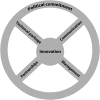Six components necessary for effective public health program implementation
- PMID: 24228653
- PMCID: PMC3910052
- DOI: 10.2105/AJPH.2013.301608
Six components necessary for effective public health program implementation
Abstract
Public health programs succeed and survive if organizations and coalitions address 6 key areas. (1) Innovation to develop the evidence base for action; (2) a technical package of a limited number of high-priority, evidence-based interventions that together will have a major impact; (3) effective performance management, especially through rigorous, real-time monitoring, evaluation, and program improvement; (4) partnerships and coalitions with public- and private-sector organizations; (5) communication of accurate and timely information to the health care community, decision makers, and the public to effect behavior change and engage civil society; and (6) political commitment to obtain resources and support for effective action. Programs including smallpox eradication, tuberculosis control, tobacco control, polio eradication, and others have made progress by addressing these 6 areas.
Figures
References
-
- Foege WH. House on Fire: The Fight to Eliminate Smallpox. Berkeley, CA: University of California Press; 2011.
-
- Centers for Disease Control and Prevention. Guide to community preventive services. Available at: http://www.thecommunityguide.org. Accessed September 12, 2013.
-
- Chopra M, Binkin NJ, Mason E et al. Integrated management of childhood illness: what have we learned and how can it be improved? Arch Dis Child. 2012;97(4):350–354. - PubMed
-
- Global Tuberculosis Report 2013. Geneva, Switzerland: World Health Organization; 2013.
MeSH terms
LinkOut - more resources
Full Text Sources
Other Literature Sources


